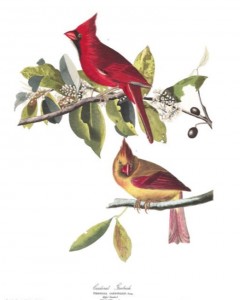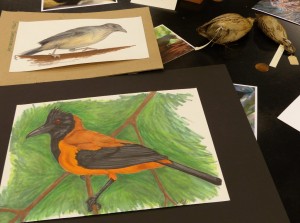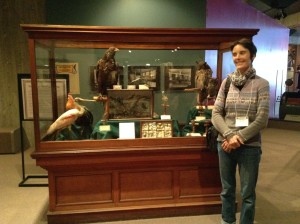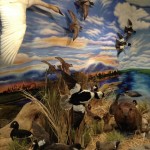When you walk into the tetrapods collection at the OSU Museum of Biological Diversity a typical reaction is to “Ohhh” and “Ahh” over the specimens around you.
Depending on your background though you may be amazed by the scientific value of these specimens (some date from the late 1800s as indicated on their labels) or you may see the artistic beauty with which some of these specimens have been preserved. Many of the early naturalists who collected specimens were artists and natural history collections have inspired artists ever since. For example, the beautiful drawings of the birds of America by the well-known American ornithologist John James Audubon.
These artworks are not only beautiful to look at, they have a scientific purpose: they provide evidence of new species described in the field and depicted in detail. Similarly field notebooks of scientists are full of drawings and illustrations, but it can be hard to capture detailed features of fast moving animals. Thus the study of preserved specimens in a museum setting has advantages and can lead to some beautiful artwork. The perfect synergy between science and art at a museum.
The role of art in natural history collections has changed over time. During the Victorian era (1837 – 1901) the study of natural history was very popular and naturalists along with museums developed new ways to showcase their findings and make science accessible to people. Many private collectors preserved animals and plants and artfully displayed them at their homes to impress guests. Later some of these private collection would materialize into the natural history collections that exist today.
In the late 19th century naturalists called for the help of artists as they started placing animals into a background of their natural environment: the natural history diorama was born. These displays are characterized by 2- and 3-dimensional elements such as a background painting depicting the habitat of the animals and taxidermied mounts of birds and other creatures placed in the foreground.
Some of the original dioramas have been preserved and you may be lucky to see one during your next museum visit. But even in today’s technological age displaying specimens in an apparently natural setting, i.e. in front of a painting of natural habitat can bring back the charm of old days. For a visual treat and to learn more about native Ohio species visit the Beaver Creek Wildlife education center in East Liverpool, Ohio.
- Waterbirds as you may see them along lake Erie
- A Green Heron on a log in a marsh and an American Wigeon in the back
- Display of a Wild Turkey on the right and a Ruffed Grouse on the fence in front, Barn Owl in the back
Even in a place where we do not artfully show off specimens to the public, art can meet science. Today’s artists, too, are aware of the treasure trove natural history collections present. Bring in a textual artist and they will admire the textures of nature, the smooth egg shell, the feathery bird, the wrinkled skin on a bird’s leg, the smooth surface of a bone. Over the years numerous students in OSU art classes have explored the artistic value of our specimens and many were inspired.
Art has changed over the years and today technology is an important element in creating artworks. We have embraced this in our latest project in collaboration with artists here at OSU: BioPresence aims to document animals that we share our spaces with on campus. Everyone is encouraged to take a photo (or make a drawing if this post has inspired you) of an animal that you encounter on campus and post it on a social media site with #animalOSU.
This project will culminate in an art exhibit on campus and in town during early December. Details will follow soon!
About the Authors: Dr. Angelika Nelson is curator of the Borror Laboratory of Bioacoustics; her research interests are in acoustic behavior and female choice in songbirds; she teaches a course on Ohio Birds at OSU each spring.
Stephanie Malinich is the Collection Manager for the Tetrapod Collection.







medokjitu bandar togel resmi terlengkap.